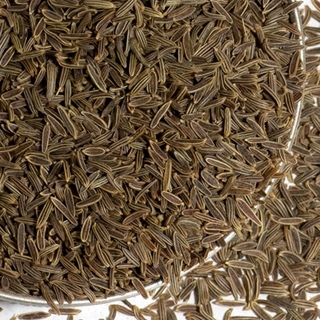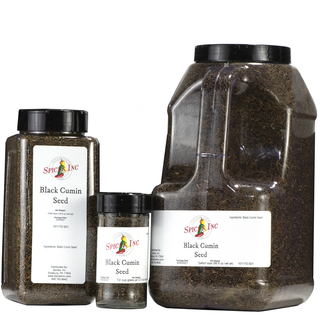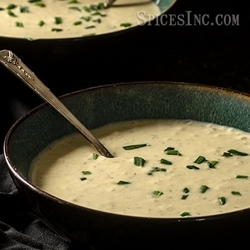Black Cumin Seed




Black Cumin Seed
Black Cumin Seeds, Bunium persicum, are also known as Elwendia persica, Kala Jeera, Shaahi (or Shahi) Jeera, or Black Caraway.
This little seed has an essential oil content that averages between 5-6% by weight, giving it surprising pungency.
There is a mountainous assortment of conflicting information that surrounds Black Cumin Seeds; we are here to help sort this out.
What Are Black Cumin Seeds?
The plant that gives us Black Cumin Seeds is a member of the Apiaceae (also called the Umbelliferae) family. They are so names because the plants form umbrella-like flowers which then turn to seed. This botanical family has enormous culinary significance; not only does it give us the different kinds of cumin, but it also produces carrots, celery, parsley, dill, and fennel.
These small, tapering seeds are about an eighth of an inch long and only a sliver wide. They have the characteristic striping that you’d see on their cousins, the conventional white Cumin Seeds, only—not surprisingly—they’re darker.
Black Cumin Seeds are most commonly found in the recipes of northern India, Afghanistan, and Iran.
Black Cumin Seed History
Black Cumin Seed is indigenous to the warmer regions of central Asia and the southern slopes of the Himalayas, around Pakistan, Tajikistan, and India. Black Cumin Seeds have been used for more than 2,000 years in Ayurvedic medicine, as a natural carminative and miracle cure that could alleviate all forms of maladies, from diabetes to sore throats. In those regions, the root of the Black Cumin Seed is also eaten as a vegetable; it’s called a “ground chestnut” and is, indeed, sweet and chestnutty.
One of the alternate names of this spice is shaahi jeera, which roughly translates as “Imperial cumin”. This indicates its importance in Mughal cooking; the Mughals were an Uzbeki army led by the warrior-chieftain Babur, who invaded India in 1526 and defeated the Sultan of Delhi. At the height of their regime they ruled almost all of the Indian subcontinent, from what is now Bangladesh in the east, past Kabul and Kashmir in the northwest. They did not manage to conquer the southernmost point of India or the island of Sri Lanka. Mughals were famous for their food and many of their dishes, like the wrapped dish samosa or the simmered rice delicacy biryani, are still eaten and enjoyed today. Black Cumin Seed, available through most of the Mughal Empire, was the preferred cumin in their dishes.
Conventional Cumin Seed has a warm and earthy flavor that’s more adaptable to cuisines around the world, so it’s become the standard cumin that’s commonly sought after. Black Cumin Seed offers a bit more pungency; while it’s still commonly used in India and central Asia, it’s not often looked for in other cuisines.
Black Cumin Seed Cultivation
Black Cumin Seeds are the fruit of a plant that puts out small white clusters of flowers. These plants are fairly small, staying between one and two feet in height. Seeds prefer to germinate in cool, or even cold, temperatures, achieving germination at about 40°F. Warmer weather sends the seeds into dormancy that can last months beyond their standard dormancy; in native conditions, plants that are sown in November emerge from their dormant stage in April. These plants can also reproduce by buds on their tubers. A three year old plant can put out as many as 5 buds from its tuber, which can then be split off and transplanted. Plants should be 8-10 inches apart for best growth. Black Cumin plants prefer moist, well-drained soil with a neutral pH. They do best with full sunlight.
It can take Black Cumin Seeds up to two years to reach full maturity; plants that are, on average, approximately eight years old produce the highest yields. Fruits turn brown when they are ripe and ready to harvest, and once browning occurs, the cumin should be harvested within two weeks. Whole stalks are harvested and then set out in the sun for up to 7 days to dry. Once the seeds are fully dry they are threshed and winnowed to separate them from the stalks, and then stored in a cool room until they are steam distilled and prepared for commercial use. On average, one hectare (2.47 acres) of land dedicated to Black Cumin farming can produce one half-ton of Black Cumin Seed.
Where Is Our Black Cumin Seed From
Our Black Cumin Seed is cultivated in India.
What Does Black Cumin Seed Taste Like
Black Cumin Seeds are fragrant, with echoes of dill and licorice aroma floating around in the top notes. They are at first bitter and earthy, a little oily, and give a touch of smoke and nut. It fades into a sweeter, mellow, almost vegetal flavor. That dissipates at the end, as a camphoraceous astringency pushes through at the finish.
What Are The Different Black Seeds
There are many spices that are called “black seeds”, and they all resemble each other and/or share similar sounding names. The variety that we have comes from the plant Bunium persicum. This slender, crescent-shaped seed is a member of the Umbelliferae family, and is also known as the great pignut or groundnut. Every part of this plant is edible, from the roots to the leaves to the seeds. The Umbelliferae family is the same family as conventional cumin. It contains plants like carrots, parsley, and parsnips, and is named for the way the plants bloom—with large clusters of small flowers that resemble umbrellas shading the underside of the plant.
Nigella Seeds, Nigella sativa, is also called “black cumin”, or simply “black seed”. In Hindi, this spice is often called Shah jeera or kalonji. To add some confusion to the mix, this spice can also be called kala jeera, particularly if the recipes are of Bengal origin. It is not related to conventional cumin; Nigella Sativa is a member of the Ranunculaceae family, which is the family that contains buttercups and columbine. This seed looks physically different than kalijiri or kala jeera; it is not long and slender but rather, teardrop-shaped with an almost triangular hull.
Black Sesame Seed, Sesamum indicum, is often confused for Nigella Sativa. It is most likely the oldest cultivated crop in the world, originating somewhere in India and valued for its flavor and oil, which makes up about 50% of the seeds’ content by weight. Black Sesame Seeds are small and shaped like a teardrop, but their hulls are smooth and rounded. Their distinctive nutty flavor and aroma should immediately set them apart from the other seeds.
These spices are often called for interchangeably in Indian cooking, so if you’re making Indian dishes it is in your better interests to find out which particular spice your recipe is asking for.
What is Black Cumin Seed Used For
You can use Black Cumin Seed anywhere you’d use regular cumin seed but want a more pungent kick. Where conventional cumin is earthy and warm, with a hint of smoke and citrusy top notes, Black Cumin Seed is bitter and nutty, with a rich mouthfeel and carrot-like top notes. Try it toasted and tossed with carrots roasted in butter and cardamom. Stir a teaspoon into Chicken Tikka Masala. Use it to balance the sweetness of carrot or butternut squash soup. Mix into tofu crumbles and brown for a rich and hearty vegetarian taco filling. Toss over chunks of lamb and skewer for kabobs, or put lamb in a tagine with onions and chickpeas and put it in the oven until buttery soft.
If you’d like to further explore Indian cuisine, try adding extra depth to traditional Butter Chicken with some toasted Black Cumin Seed, or add half a teaspoon of toasted, ground Black Cumin Seed to Punjabi Chicken with Tomatoes and Spinach.
Black Cumin Substitutions and Conversions
Since it is more pungent than conventional white cumin, we recommend using 3/4 teaspoon of Black Cumin Seed for every teaspoon of whole Cumin Seed. Taste, and then add more if you wish.
| Ingredients | Black Cumin |
| Also Called | Elwendia persica, Kala Jeera, Shaahi (or Shahi) Jeera, or Black Caraway. |
| Recommended Uses | Use in Indian curries, soups, over vegetables |
| Flavor Profile | Earthy and fragrant, with a nutty finish and elements of dill and licorice in the aroma. |
| Botanical Name | Bunium persicum |
| Oil Content | 4%-6% |
| Cuisine | Indian, Pakistani, Afghan |
| How To Store | Airtight container in a cool, dark place |
| Shelf Life | 1-2 Years |
| Country of Origin | India |
| Dietary Preferences | Gluten Free, Kosher, Non-GMO |
Hungry for more information?
Sweet and Bitter Flavors
Middle Eastern Spices, Seasonings, and Food
Flavor Characteristics of Spices
Indian Spices and Seasonings
Nutrition Facts
Serving Size1 tsp
Amount Per Serving
Calories9
% Daily Value*
Total Fat1g1%
Saturated Fat0g0%
Trans Fat0g
Polyunsaturated Fat0g
Monounsaturated Fat0g
Cholesterol0mg0%
Sodium3.9mg0%
Total Carbohydrate1.0g0%
Dietary Fiber0.3g1%
Total Sugars0.0g
Added Sugars0g0%
Sugar Alcohol0.0g
Protein0.4g1%
Vitamin D0mcg0%
Calcium22mg2%
Iron2mg9%
Potassium42mg1%
*The % Daily Value (DV) tells you how much a nutrient in a serving of food contributes to a daily diet. 2,000 calories a day is used for general nutrition advice. These values were calculated and therefore are approximate. For more accuracy, testing is advised.


